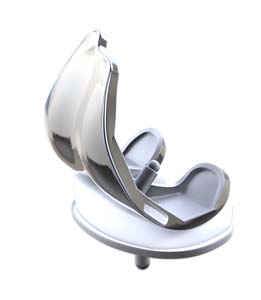
If you are considering knee replacement surgery, there are new developments under study which can help enhance the quality of life. These include:
- Use of cementless parts that allow new bone to grow into a porous prosthesis and hold the parts in place, creating a biologic fixation
- Use of bioactive joint surfaces such as hydroxyapatite
- Use of mobile-bearing knee replacement in which a polyethylene insert creates a dual-surface articulation by articulating with the femoral as well as tibial components. This will enhance the life of the implant by reducing wear.
- Development of systems with improved kinematics
- Better fixation
- Use of navigation-guided surgery that involves the use of navigation-guided instruments with smaller incisions and less tissue damage.
Only suitably-trained surgeons with various skills offer these procedures.
Related Topics:
- Partial Arthroscopic Meniscectomy
- Robotic Unicondylar Knee Replacement
- Combined Hyaluronic Therapy for the Knee
- Correction of a Failed Knee Replacement
- Correction of a Loose Knee Replacement
- Correction of a Painful Knee Replacement
- Arthroscopic Debridement
- Painful or Failed Total Knee Replacement
- Meniscectomy
- Minimally Invasive Knee Joint Replacement
- Outpatient Unicondylar Knee Replacement
- Partial Knee Resurfacing
- Prior Meniscectomy
- Unicondylar knee Replacement
- Periprosthetic Knee Fracture Fixation
- Viscosupplementation
- Knee Arthroscopy
- Unicompartmental/Partial Knee Replacement
- Patellofemoral Knee Replacement
- What is New in Knee Replacement
- Computer Navigation for Total Knee Replacement
- Total Knee Replacement
- Revision Knee Replacement
- Robotic Assisted Knee Replacement
- Robotic Assisted Partial Knee Surgery
- Outpatient Total Knee Replacement
- Tricompartmental Knee Replacement
- Partial Meniscectomy
- Meniscal Surgery
- Partial Lateral Knee Replacement
- Partial Medial Knee Replacement

